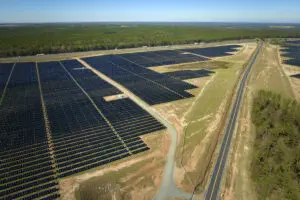 There’s a lot of empty land along California’s highways — and the state will soon be looking at how it can fill some of it up with solar panels, batteries and power lines to help meet its clean energy targets.
There’s a lot of empty land along California’s highways — and the state will soon be looking at how it can fill some of it up with solar panels, batteries and power lines to help meet its clean energy targets.
That’s the goal of SB 49, a bill passed by California lawmakers and now awaiting the signature of Governor Gavin Newsom (D). The bill orders the California Department of Transportation to “evaluate the suitability” of the land it owns alongside highway roadways, exits and interchanges for developing renewable energy, energy storage and electrical transmission and distribution facilities.
In a statement, State Sen. Josh Becker, the bill’s author, highlighted the potential for SB 49 to “get much-needed renewable energy built, support clean energy jobs and earn the state some extra revenue in the process” via lease payments from clean energy developers.
SB 49 isn’t the highest-profile of the climate and energy bills passed in California’s busy legislative session, nor will it lead to immediate building along the rights of way the state’s Department of Transportation owns and manages along 52,000 miles of state highways and nearly 15,000 miles of federal interstate highways that criss-cross California. The bill gives the agency until 2025 to finish analyzing the potential for the land under its control and the steps it must take within state law, and in coordination with state energy and utility regulators, to make the development possible.
But Laura Deehan, state director of nonprofit group Environment California, one of SB 49’s key backers, believes that California could move relatively quickly to turn its highways into clean energy corridors.
“This is a no-brainer for our state. Why isn’t it happening?” she said. “It seems like this is one of those cases where inertia is the main opponent.”
Other states are already earning money from solar panels built in the empty land surrounding highways and interchanges.
Did you know? By 2030, up to 200 TWh of solar power could be annually generated along Germany’s autobahn network.
These projects make up only a tiny fraction of the utility-scale clean energy projects in the U.S. at present, but studies have found potential for gigawatts of solar and thousands of miles of high-voltage transmission using otherwise unusable highway rights of way. Given the challenge of siting and permitting the hundreds of gigawatts of clean energy and transmission grid infrastructure needed to decarbonize the U.S. power grid, land that can’t be used for other purposes should be treated as a windfall for the energy transition, she said.
Every state has its own rules and regulations for what can be done alongside highways that can complicate its use for clean energy. That land must be kept clear of anything that would imperil driver safety, be maintained to limit environmental harms, and sometimes be kept available for highway expansion. But states including Oregon, the first to explore highway solar, as well as Maine, Maryland and Massachusetts, have set up structures for siting solar and supporting grid infrastructure within state-owned highway rights of way, giving California and other states a template to follow, Deehan noted.
And while states must coordinate their use of federal interstate rights of way with the Federal Highway Administration, that agency has already instructed states to put that land to use for “clean energy and connectivity” projects including high-voltage transmission, broadband internet, EV charging, and solar and wind power. That’s an important shift from federal policies that used to prohibit utility infrastructure on interstate rights of way, she said.
California needs a lot more clean energy and grid infrastructure to meet its climate goals, she added — and a lot of the land needed for that expansion is already being used for farming or protected for environmental reasons. Rooftop solar can fill in some of this need, but it comes with its own policy complications.
Leave a Reply